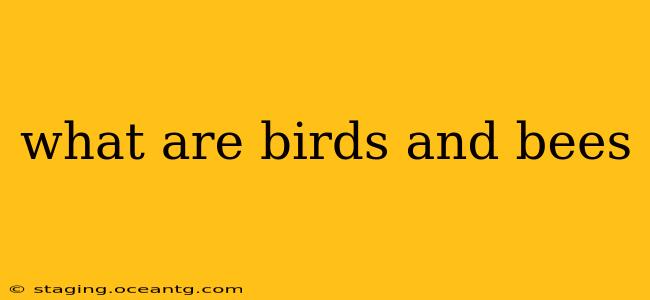The phrase "birds and bees" is a common euphemism for explaining the facts of life and reproduction to children. However, the actual birds and bees themselves are fascinating subjects of study, each representing vastly different branches of the animal kingdom. Let's delve into the intricacies of avian and insect life, moving beyond the simplified explanation of human reproduction.
What are Birds?
Birds (class Aves) are warm-blooded vertebrates, characterized by feathers, toothless beaked jaws, the laying of hard-shelled eggs, a high metabolic rate, a four-chambered heart, and a strong yet lightweight skeleton. Their unique adaptations enable flight, although some species, like penguins and ostriches, are flightless.
Key Characteristics of Birds:
- Feathers: These provide insulation, aid in flight, and contribute to courtship displays.
- Wings: Modified forelimbs enabling flight (in most species).
- Beaks: Varied shapes adapted to different diets.
- Hollow Bones: Lightweight yet strong, contributing to flight efficiency.
- High Metabolic Rate: Supports flight and other energy-intensive activities.
- Egg-Laying: Reproduction occurs through the laying of hard-shelled eggs.
What are Bees?
Bees (order Hymenoptera, family Apidae) are flying insects closely related to wasps and ants. They are known for their crucial role in pollination, their complex social structures (in many species), and the production of honey and beeswax. Not all bees live in hives; many are solitary creatures.
Key Characteristics of Bees:
- Pollination: Bees transfer pollen between flowers, crucial for plant reproduction.
- Social Structure: Many bee species live in highly organized colonies with a queen, workers, and drones.
- Honey Production: Honeybees store nectar as honey, a crucial food source.
- Wax Production: Beeswax is used to construct honeycombs.
- Stinger: A defensive mechanism used to protect the colony.
- Variety of Species: There are thousands of bee species, exhibiting diverse behaviours and appearances.
What is the Life Cycle of a Bird?
The life cycle of a bird typically involves:
- Incubation: Eggs are incubated by the parents until they hatch.
- Hatching: The young emerge from the egg.
- Fledgling Stage: The young birds are dependent on their parents for food and protection.
- Maturity: The birds reach sexual maturity and can reproduce.
What is the Life Cycle of a Bee?
The life cycle of a bee varies depending on the species and its role within the colony. Generally, it involves:
- Egg: The queen bee lays eggs.
- Larva: The eggs hatch into larvae, fed by worker bees.
- Pupa: The larvae pupate, undergoing metamorphosis.
- Adult: The adult bee emerges, taking on a specific role within the colony (queen, worker, or drone).
How Do Birds and Bees Contribute to the Ecosystem?
Both birds and bees play vital roles in maintaining ecosystem health.
- Birds: Many birds are important seed dispersers, insect predators, and scavengers. They contribute to pollination and control pest populations.
- Bees: Bees are the primary pollinators for many plants, ensuring the reproduction of a vast array of flowering species, which in turn supports diverse ecosystems.
Are Birds and Bees Related?
Birds and bees are not closely related. Birds are vertebrates (animals with backbones), while bees are invertebrates (animals without backbones). They belong to entirely different classes and phyla within the animal kingdom. Their similarities are largely due to convergent evolution—the independent evolution of similar traits in response to similar environmental pressures (such as the need for efficient locomotion in the case of flying).
This detailed exploration of birds and bees goes beyond the simple explanation often used to introduce the concept of reproduction. It highlights the significant roles these animals play in our environment and demonstrates the incredible diversity within each group.
